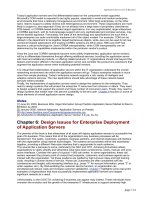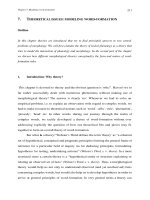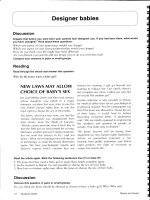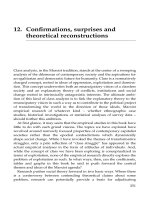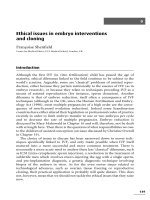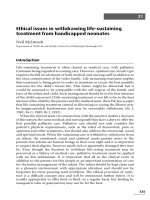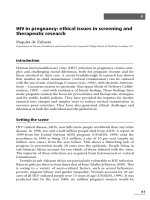Theoretical issues - modeling word-formation
Bạn đang xem bản rút gọn của tài liệu. Xem và tải ngay bản đầy đủ của tài liệu tại đây (119.25 KB, 44 trang )
Chapter 7: Modeling word-formation
211
7. THEORETICAL ISSUES: MODELING WORD-FORMATION
Outline
In this chapter theories are introduced that try to find principled answers to two central
problems of morphology. We will first examine the theory of lexical phonology as a theory that
tries to model the interaction of phonology and morphology. In the second part of the chapter
we discuss how different morphological theories conceptualize the form and nature of word-
formation rules.
1. Introduction: Why theory?
This chapter is devoted to theory and the obvious question is ‘why?’. Haven’t we so
far rather successfully dealt with numerous phenomena without making use of
morphological theory? The answer is clearly ‘no’. Whenever we had to solve an
empirical problem, i.e. to explain an observation with regard to complex words, we
had to make recourse to theoretical notions such as ‘word’, ‘affix’, ‘rule’, ‘alternation’,
‘prosody’, ‘head’ etc. In other words, during our journey through the realm of
complex words, we tacitly developed a theory of word-formation without ever
addressing explicitly the question of how our theoretical bits and pieces may fit
together to form an overall theory of word-formation.
But what is a theory? Webster’s Third defines the term ‘theory’ as “a coherent
set of hypothetical, conceptual and pragmatic principles forming the general frame of
reference for a particular field of inquiry (as for deducing principles, formulating
hypotheses for testing, undertaking actions)” (Webster’s Third, s. v. theory). In a more
restricted sense a certain theory is a “hypothetical entity or structure explaining or
relating an observed set of facts” (Webster’s Third, s. v. theory). Thus, a morphological
theory would help us not only to understand observed (and yet unobserved) facts
concerning complex words, but would also help us to develop hypotheses in order to
arrive at general principles of word-formation. In very general terms a theory can
Chapter 7: Modeling word-formation
212
help us to understand the world (better). This is also the idea behind the saying that
there is nothing as practical as a good theory.
With this in mind, we will take a look at two particular theoretical problems
which have been mentioned repeatedly in the preceding chapters, but which we
have not solved in a principled manner. The first of these problems is the interaction
of phonology and morphology, the second the form and nature of word-formation
rules.
As we will see, there are a number of different criteria by which a theory can
be judged, the most important of which are perhaps internal consistency, elegance,
explicitness and empirical adequacy. With regard to the criterion of internal
consistency, it should be evident that a theory should not contradict itself.
Furthermore, a theory should be elegant in the sense that it uses as little machinery
(entities, rules, principles, etc.) as possible to explain an observed set of facts. And the
explanations should be as explicit as possible, so that clear hypotheses can be
formulated. This is important because hypotheses must be falsifiable, and only clear
hypotheses can be clearly falsified. Finally, the theory should be empirically
adequate in the sense that it can account for the observable data.
Equipped with this background information on theories in general, we are
now in the position to examine the theory of ‘lexical phonology’, which tries to
explain the relationship between phonology and morphology in a principled fashion.
2. The phonology-morphology interaction: lexical phonology
2.1. An outline of the theory of lexical phonology
In the previous chapters we have frequently seen that morphology and phonology
interact. For example, we have observed that certain suffixes inflict certain stress
patterns on their derivatives (as in prodúctive - productívity) or are responsible for the
deletion of segments (feminine - feminize). We also saw that compounds have a
particular stress pattern. However, we have not asked ourselves how this interaction
Chapter 7: Modeling word-formation
213
of phonology and morphology can be conceptualized in an overall theory of
language.
In order to understand the main ideas of Lexical Phonology, it is helpful to
briefly look at the history of the school of linguistic thought called generative
grammar. In early generative grammar it was assumed that well-formed sentences as
the output of the language system (the ‘grammar’) are generated in such a way that
words are taken from the lexicon and inserted into syntactic structures. These
structures are then interpreted semantically and pronounced according to the rules
of the phonological component. A schematic picture of such an approach is given in
(1). The schema abstracts away from particular details of the various models that
have been proposed and revised over the years (see e.g. Horrocks 1987 for an
overview):
(1)
In this model, phonological processes crucially apply after all morphological and
syntactic operations have been carried out, i.e. after all word-formation rules or
inflectional rules have been applied and the words have been inserted into syntactic
structures. A number of generativists soon realized, however, that, contrary to what
the model predicts, there is significant interaction of phonology and morphology in
the derivation of complex words, which led to the idea that certain phonological
rules must apply before a given word leaves the lexicon and is inserted into a
syntactic structure. In other words, parts of the phonology must be at work in the
phrase structure rules lexicon
sentence structure
semantic component phonological component
Chapter 7: Modeling word-formation
214
lexicon, and not only post-lexically, i.e. after the words have left the lexicon and are
inserted into a syntactic tree. The theory that wants to account for the application of
phonological rules in the lexicon is therefore aptly named lexical phonology.
The basic insight of lexical phonology is that phonology and morphology
work in tandem. There are phonological rules that are triggered only by the
affixation of a particular morpheme, and which apply in a cyclic fashion. The word
‘cyclic’ means here that whenever a new affix is added in a new derivational cycle,
the pertinent rule can apply on that cycle. For example, each time we attach a given
stress-shifting suffix to a given base, we must apply the pertinent stress rule (cf.
seléctive - selectívity). If more than one affix is attached, cyclic phonological rules
reapply at each step in the derivation of a particular word. Before we can see in more
detail how this works we need to take a brief look at so-called level-ordering.
The concept of cyclic rule application has built heavily on work by Siegel
(1974) and Allen (1978), who assume the existence of two levels or strata in English
derivational morphology. English derivational suffixes and prefixes each belong to
one of two levels. In (2) I have a listed a number of suffixes according to the level to
which they supposedly belong (cf. also Spencer 1991:79):
(2) Level I suffixes: +al,+ate, +ic, +ion, +ity, +ive, +ous
Level I prefixes: be+, con+, de+, en+, in+, pre+, re+, sub+
Level II suffixes: #able, #er, #ful, #hood, #ist, #ize, #less, #ly, #ness, #wise
Level II prefixes: anti#, de#, non#, re#, sub#, un#, semi#
Affixes belonging to one stratum can be distinguished from the affixes of the other
stratum by a number of properties (some of these properties were already discussed
in chapter 4, section 2, but without reference to level-ordering).
First, level 1 affixes tend to be of foreign origin (‘Latinate’), while level 2
affixes are mostly Germanic. Second, level 1 affixes can attach to bound roots and to
words, while level 2 affixes attach to words. For example, in electric the suffix
attaches to the root electr-, while the adjective-forming level 2 suffix -ly only attaches
to words (e.g. earthly). This difference in the strength of morphological boundaries is
expressed by the ‘+’ and ‘#’ notation in (2), with ‘+’ standing for a root boundary and
Chapter 7: Modeling word-formation
215
‘#’ standing for a word boundary. The difference in boundary strength leads to the
third difference between the two levels. Level 1 affixes tend to be phonologically
more integrated into their base than level 2 affixes, with stratum 1 suffixes causing
stress shifts and other morpho-phonological alternations, while stratum 2 suffixes do
not affect their bases phonologically. Finally, stratum 1 affixes are generally less
productive than stratum 2 affixes.
With reference to the two levels, an interesting property of English derivation
can be captured: their combinability with other affixes. According to the so-called
level-ordering hypothesis, affixes can easily combine with affixes on the same level,
but if they combine with an affix from another level, the level 1 affix is always closer
to the base than the level 2 affix. For example, level 1 suffix -(i)an may appear inside
level 2 -ism but not vice versa (cf. Mongol-ian-ism, but *Mongol-ism-ian). Level-
ordering thus rules out many unattested combinations of affixes on principled
grounds.
Coming back to cyclic rule application, the interaction of morphological and
phonological rules can be schematized as in (3). The model as presented here is based
on different studies in lexical phonology and ignores existing minor differences
between the pertinent authors (e.g. Kiparsky 1982, Mohanan 1986) in order to bring
out clearly the most important aspect of the theory, the interaction of morphological
and phonological rules. For reasons that will become clear shortly, the model also
includes regular and irregular inflection.
Chapter 7: Modeling word-formation
216
LEXICON
(3) A model of lexical phonology
underived
lexical item
level 1 morphology
‘+’-derivation (e.g.+(i)an, +ic)
irregular inflection
level 1 phonology
e.g. stress shift, trisyllabic
shortening, velar softening
level 2 morphology
‘#’-derivation (e.g. #ism, #ness),
regular inflection, compounding
level 2 phonology
e.g. compound stress
SYNTAX
Chapter 7: Modeling word-formation
217
How does the model work? In the words of Mohanan, lexical phonology can be
compared to a factory, with the levels as individual rooms in which words are
produced: “There is a conveyor belt that runs from the entry gate to the exit gate
passing through each of these rooms. This means that every word that leaves the
factory came in through the entry gate and passed through every one of these
rooms” (1986:47). Let us illustrate this with the derivation of the potential compound
word Mongolianism debates. This word would be derived by first subjecting the
underived lexical item Mongol to +(i)an suffixation. Having attached -ian, the form
Mongolian is transferred to the ‘level 1 phonology’ box, where stress is assigned on
the syllable immediately preceding the suffix. Mongólian is then, on the next cycle,
transferred to level 2 morphology where it receives the suffix -ism and is handed over
to level 2 phonology. Not much happens here for the moment, because -ism, like all
level 2 suffixes, is stress-neutral. The form is transferred back to level 2 morphology
where it is inserted into a compound structure together with the right-hand element
debate. The compound goes to level 2 phonology to receive compound stress and is
then handed back to become pluralized, i.e. adopt regular inflectional -s. Back in level
2 phonology again, inflectional -s is interpreted phonologically (as one of the three
possible regular allomorphs). The word is now ready to leave the lexicon and to be
inserted into a syntactic structure. Fair enough, you might be tempted to say, but
what do we gain with such a model? This is the topic of the next section.
2.2. Basic insights of lexical phonology
To answer the question of what lexical phonology has to offer, we can say that the
model makes interesting predictions about the behavior of morphological units and
helps us to explain a number of generalizations that emerge from the data and that
we have dealt with in the previous chapters.
One prediction we have already mentioned above concerns the order of many
affix-affix combinations. According to the level-ordering hypothesis a given level 1
affix must attach before a level 2 affix, because level 2 output cannot feed level 1.
Thus, the impossibility of, for example, *atom-less-ity follows from the fact that -less is
Chapter 7: Modeling word-formation
218
level 2, whereas -ity is level 1. Level 1 affixes inside level 2 affixes are fine (cf. curi-
ous-ness), and so are combinations within a given level (cf. electr-ic-ity, atom-less-ness).
The model can also explain an interesting interaction between compounding
and inflection, and between conversion and inflection. Consider, for example, the
problem why compounds like walkman and converted nouns like to grandstand do not
take irregular inflection, as would be expected on the basis of their right-most
elements man and stand (cf. walkmans vs. *walkmen and grandstanded vs. *grandstood).
In the above model these facts fall out automatically: assuming that irregular
morphology is a level 1 process and further assuming that compounding and noun-
to-verb conversion are both level 2 processes, irregular inflectional marking is no
longer a possibility for these forms because there is no loop back from level 2 to level
1. Regular inflection (i.e. plural -s and past tense -ed), which, according to the model
in (3), operates on level 2, is the only possible way of marking these grammatical
categories with these formations.
Talking about conversion, the model can also help us to solve the
directionality problem of conversion, at least with noun-to-verb and verb-to-noun
conversion. In chapter 5, section 1.1., we have argued that stress shift in otherwise
homonymous verb-noun pairs is an indication of verb-to-noun conversion (e.g. to
protést - the prótest). In terms of lexical phonology, verb-to-noun conversion must be a
stratum 1 process, because only on this level is there the possibility to change the
stress of the base word. In contrast, noun-to-verb conversion is stress-neutral, hence a
level 2 process. A look at the productivity corroborates this. As we have said above,
level 1 processes are generally less productive than level 2 processes, which would
lead us to the hypothesis that level 1 verb-to-noun conversion must be significantly
less productive than noun-to-verb conversion. And this is exactly what we find.
Finally, the model can account for a phenomenon we discussed in chapter 3,
namely the blocking of regular derived forms by existing synonymous forms. In
terms of lexical phonology, blocking can be accounted for by the idea that the
application of a given rule at one stratum blocks the application of the same rule at a
later stratum. For example, the suffixation of the irregular plural to form oxen blocks
the application of the more general, regular plural suffix -s. This is an instance of the
so-called elsewhere condition, which states that the special rule has to apply first,
Chapter 7: Modeling word-formation
219
and the more general rule ‘elsewhere’ (cf. our formulation of morpho-phonological
alternations in chapter 2, section 2). Extending this idea to derivational morphology,
we could explain why nouns converted from verbs like cook, bore, spy block
synonymous words with the agentive suffix -er (cf. *cooker, *borer, *spyer). Verb-to-
noun conversion (e.g. cook
VERB
→ cook
NOUN
) is level 1, while -er is attached at level 2.
The application of the rule of agentive formation by verb-to-noun conversion at level
1 preempts the attachment of agentive -er on a later cycle. This does not mean that it
is totally impossible to add -er to, for example, cook. The point is that if an agentive
meaning is chosen at level one, this meaning is no longer available at level 2. Hence,
the form cooker must receive another interpretation (e.g. an instrumental one).
In sum, lexical phonology sheds light on four different problem areas, namely
the serial application of morphological processes and the co-occurring phonological
operations, the productivity of different processes, the direction of conversion, and
the phenomenon of blocking. Lexical phonology has, however, been severely
criticized on both empirical and conceptual grounds, and we will turn to this
criticism in the next section.
2.3. Problems with lexical phonology
The obvious empirical problem is that the model does not say anything about
possible and impossible combinations within a given stratum, thus leaving large
amounts of data unaccounted for. Fabb (1988) finds that the 43 suffixes he
investigates are attested in only 50 two-suffix combinations, although stratum
restrictions would allow 459 out of the 1849 possible ones. In order to explain
combinations within strata, individual selectional restrictions like those discussed in
chapter 3, section 5.2, are needed in any case, and, as argued in Plag (1996, 1999),
these selectional restrictions then also account for the would-be stratal behavior of
sets of affixes. This idea will be further illustrated in section 2.4. below.
Another empirical weakness of level-ordering is that there are a number of
attested suffix combinations that are unexpected under the assumption of level-
ordering. Thus stress-neutral -ist appears systematically inside stress-shifting -ic (e.g.
Chapter 7: Modeling word-formation
220
romant-ic - romant-ic-ist), or stress-neutral -ize appears systematically inside stress-
shifting -(at)ion (e.g. colon-iz-ation, see also exercise 3.1. of chapter 3).
One major theoretical drawback of level-ordering is that the two strata are not
justified on independent grounds. In other words, it is unclear what is behind the
distinction between the two strata, and which property makes a suffix end up on a
given stratum. Originally, it has been suggested that the underlying distinction is one
of etymology (borrowed vs. native, e.g. Saciuk 1969), but this does not explain why
speakers can and do master English morphology without etymological knowledge.
Others have argued that the stratum problem is in fact a phonological one, with
differences between different etymological strata being paralleled by phonological
differences. For example, Anshen et al. (1986) show that etymology correlates with
the number of syllables: Latinate bases tend to be polysyllabic, Germanic bases
mono- or disyllabic. This approach has the advantage that it would allow speakers to
distinguish between the strata on the basis of the segmental and prosodic behavior of
derivatives. However, explaining the nature of the strata as following from
underlying phonological properties of suffixes does in fact weaken the idea of strata,
because, as shown by Raffelsiefen (1999), not even two of the many suffixes of
English trigger exactly the same type of morpho-phonological alternations, so that
we would need as many sub-strata as we have suffixes that trigger morpho-
phonological alternations.
Another serious problem is that a stratum can not be defined by the set of
suffixes it contains, because many suffixes must belong to more than one stratum:
they show stratum 1 behavior in certain derivatives, whereas in other derivatives
they display stratum 2 behavior. For example, there are forms where -able is stress-
shifting, hence stratum 1, but in the majority of cases stress-shift is absent. Even
doublets exist that show the stratum 1 and stratum 2 behavior: compárable vs.
cómparable. Another example of double membership is -ize, which attaches to some
roots (e.g. baptize), truncates its bases under certain circumstances (see chapter 4,
section 4.2.), and triggers so-called velar softening (classi[k] - classi[s]ize, see answer
key, exercise 4.3). All three properties are typical of level 1, but -ize is not stress-
shifting, attaches mostly to words and is productive, which are all typical of level 2.
Chapter 7: Modeling word-formation
221
Giegerich (1999) discusses many cases of dual membership of affixes in great
detail and - as a consequence - proposes a thoroughly revised stratal model, in which
the strata are no longer defined by the affixes belonging to that stratum, but by the
bases involved. In this revised model, both words and bound roots start out on level
1 as roots, i.e. as morphemes that do not have a part-of-speech specification yet. This
can then nicely account for the fact that many affixes attach to bound roots and to
words, because these affixes attach at level 1. According to Giegerich, such suffixes
can do so because they attach generally to roots, i.e. level 1 morphemes that are not
specified for part-of-speech yet. For example, ambiti-ous and courage-ous are both
formed at level 1, because -ous attaches to roots. But what about suffixes that only
attach to words? In Giegerich’s model, these attach only after the base morphemes
have passed on to level 2, where they have received a part-of-speech specification.
There are, however, at least two severe conceptual problems with such a
revised model. Giegerich explains the fact that some affixes attach to both bound
roots and words by simply stipulating that the words are also roots. There is,
however and crucially, no independent motivation for such a move, apart from the
fact that it makes the model work. The problem of double membership of affixes is
replaced by the problem of assigning a given word with the same form the status of a
root at level 1 and the status of a word at level 2 without independent justification.
This leads us to the second conceptual problem. If we attach a suffix at level 1,
the derived word still has no part-of-speech specification, because part-of-speech is
only assigned by root-to-word conversion at level 2. In other words, suffixes like -ous
would no longer have a part-of-speech specification, but would only receive it after
attachment to a root and after having then reached level 2, where the derived form is
subjected to the root-to-word conversion rule for which the suffix is specified. In the
case of -ous, this would be the conversion of the form from a root into an adjective.
This seems like an unnecessary and unjustified complication.
To summarize, there are major empirical and theoretical problems with lexical
phonology and the idea of level-ordering. In the following sub-section, we will
therefore explore alternative models.
Chapter 7: Modeling word-formation
222
2.4. Alternative theories
We have frequently seen throughout this book that any given affix or morphological
process comes with its particular phonological, morphological, semantic and
syntactic properties. Plag (1996, 1999) shows that these diverse properties together
are responsible for the possible and impossible combinations of a given affix both
with roots and with other affixes. What has been analyzed as would-be stratal
behavior automatically falls out from the phonological, morphological and semantic
properties of the affix. Since these properties must be stated anyway to account for
the particular behavior of a given affix, no further stratal apparatus is necessary.
Plag (1996, 1999) also incorporates the idea of base-driven suffixation to
explain apparent idiosyncrasies in suffix combinations. The idea of base-driven
restrictions in suffixation is that it is not only a given suffix that requires, or ‘selects’,
a certain kind of base, but that bases, in particular bases that contain certain suffixes,
may select a certain kind of affix. For illustration of this idea, consider the deverbal
suffixes in (4), which, according to Fabb (1988), do not to attach to any suffixed word
(this would be an affix-driven restriction):
(4) deverbal nominal suffixes not attaching to an already suffixed word
-age (as in steerage)
-al (as in betrayal)
-ance (as in annoyance)
-ment (as in containment)
-y (as in assembly)
Why should these suffixes behave in this way? And is this a property that has to be
stated in the lexical entry of each of the nominal suffixes? In an approach that only
looks at the question of which kinds of base a given affix selects this would be
essential. Let us call such an approach ‘affix-driven’. It is, however, possible to look
at the problem from a different angle, i.e. from the perspective of the base. Which
kinds of affix does a given base select? In such a base-driven approach, the
Chapter 7: Modeling word-formation
223
impossibility of the above nominal suffixes to attach to already suffixed words could
also be explained in terms of the bases, not only in terms of the nominal suffixes.
The argument with regard to the above nominal suffixes is this: the only
suffixed words that could in principle appear before deverbal -age, -al, -ance, -ment
and -y are verbs ending in -ify, -ize, -ate, and -en. However, -ify, -ize, and -ate require (a
suffix-particular allomorph of) the nominalizer -(at)ion:
(5) magnification verbalization concentration
*magnify-ation *verbalize-ification *concentrate-ation
*magnify-ion *verbalize-ion *concentrate-ification
*magnify-ance *verbalize-ance *concentrate-ance
*magnify-al *verbalize-al *concentrate-al
*magnify-age *verbalize-age *concentrate-age
*magnify-y *verbalize-y *concentrate-y
*magnify-ment *verbalize-ment *concentrate-ment
These facts suggest that the behavior of verbalizing and nominalizing suffixes is best
analyzed as base-driven: combinations of the verbal suffixes -ify, -ize, -ate with -age, -
al, -ance, -ment and -y are ruled out because it is the bases (with their particular verbal
suffixes) which select their (allomorph of the) nominalizing suffix -ion, and it is
crucially not the nominal suffix which selects its base. Of course one could say that -
ion selects -ate, -ify and -ize, but this would not explain why the other nominalizing
suffixes are systematically excluded. Hence a base-driven approach is superior in its
explanatory power.
With -en, affix-driven restrictions are responsible for the (im)possibility of
combinations. -en is not attested before -age, -al, -ance, and -y, because -ance and -al
only attach to bases that have final stress, and because the distribution of -age and -y
seems to be entirely lexically governed (see again chapter 2, section 3 for the notion
of lexical government). Contra Fabb’s claim cited above, the combination X-en-ment is
in fact attested, and crucially so in those cases where X-en does not violate the
restrictions of -ment suffixation (see Plag 1999: 70-75 for a detailed analysis).
Chapter 7: Modeling word-formation
224
In sum, the example of deverbal nominal suffixes has shown how base-driven
and affix-driven restrictions can account for possible and impossible affix-affix
combinations and root-affix combinations. A model that focuses on suffix-particular
and base-driven restrictions is empirically more adequate and theoretically more
parsimonious, because it can achieve empirical adequacy with the least possible
machinery.
A model that relies solely on affix-particular restrictions could be criticized for
the lack of generalizations across suffixes. After all, linguists want to believe that
language in general and derivational morphology in particular is not just an
accumulation of item-specific idiosyncrasies. This is the point where the
psycholinguistically informed model of complexity-based ordering comes in.
In this model, developed in Hay (2000, 2001, 2002) morphological complexity
is construed as a psycholinguistically real notion which heavily relies on the
segmentability of affixes. The basic claim concerning the problem of affix ordering is
that “an affix which can be easily parsed out should not occur inside an affix which
can not” (Hay 2000: 23, 240). For reasons that will shortly become clear, I will refer to
this approach as complexity-based ordering.
What does it mean for an affix to be “easily parsed out”? Parsing is a term
which refers to the segmentation of speech, i.e. words and sentences, in its structural
components. Morphological parsing is thus what listeners/readers do when they
detect morphological structure (or isolate morphemes) in a string of words in order
to make sense of complex words. Morphological parsing is not always easy. As is
well known, there are words that are clearly composed of two or more morphemes
(e.g. concrete-ness), there are words that are clearly monomorphemic (e.g. table), and
there are words whose status as complex words is not so clear, as discussed in
chapter 2, section 1.2. (e.g. rehearse, interview, perceive). Hay now shows that
morphological complexity is a function of the psycholinguistic notion of
morphological parsability, which in turn is largely influenced by at least two factors,
frequency and phonotactics. In order to make things simpler, we will focus here on
the role of frequency (considerations on the role of phonotactics can be found in
Hay/Baayen 2002b, and Plag 2002).
Chapter 7: Modeling word-formation
225
As already explained in chapter 3, in most current models of morphological
processing, access to morphologically complex words in the mental lexicon works in
two ways: by direct access to the whole word representation (‘whole word route’) or
by access to the decomposed elements (‘decomposed route’). Given that frequency
plays a role in determining the resting activation of lexical items, it is clear that every
access via the whole word route strengthens the whole word representation, whereas
access on the decomposed route reinforces the representation of the decomposed
morphemes and the decomposability of the complex word. How do we know which
representation will be strengthened with a given word? It is usually assumed that the
absolute frequency of a word correlates with its resting activation level. Hay suggests
that, with regard to the storage of complex words, the relative frequency of the
derived word and its base is significant. Relative frequency is defined as the ratio of
the frequency of the derived word to the frequency of the base and measures how
frequent the derivative is with respect to its base:
(6) relative frequency:
frequency of derived word divided by the frequency of the base
f
derivative
f
relative
=
f
base
With most complex words, the base is more frequent than the derived word, so that
the relative frequency is smaller than unity. In psycholinguistic terms, the base has a
higher resting activation than the derived word. This leads to preponderance of the
decomposed route, since due to its high resting activation, the base will be accessed
each time the derivative enters the system. In the opposite case, when the derived
word is more frequent than the base, there is a whole word bias in parsing, because
the resting activation of the base is lower than the resting activation of the derivative.
For example, business is more frequent than its base busy, so that business will have a
whole word bias in access. Note that business is also semantically and phonologically
opaque, which is often the case with derivatives that have strong, i.e. lexicalized,
whole word representations (see below). Conversely, blueness has a base that is much
Chapter 7: Modeling word-formation
226
more frequent than the derived form, so that there will be a strong advantage for the
decomposed route. The two cases are illustrated in (7), with frequencies taken from
the BNC:
(7)
word frequency relative
frequency
mode of access and
representation
blueness
39 .0039 parsing bias
blue
10059
business
35141 7.2 whole word bias
busy
4879
In sum, the higher the frequency of the derived word in relation to the base word, the
less likely is decomposition. Alternatively, the lower the frequency of the derived
word in relation to the base word, the more likely is decomposition.
Hay shows that relative frequency also patterns with other properties of
complex words: low relative frequency correlates with high productivity and low
relative frequency correlates with high semantic transparency. These correlations do
not come as a surprise. We know that productive morphological processes are
characterized by a high number of low frequency words. The lower the frequencies
of derived words the lower their relative frequencies (holding the frequency of the
base constant). Thus productive processes should show a preponderance of low
relative frequencies, whereas less productive morphological categories should be
characterized by a preponderance of words with higher relative frequencies. We also
know that productive categories are semantically transparent. That this is so can be
seen as a consequence of processing, since productive processes favor the
decomposed route, and decomposed storage strengthens the individual semantic
representations of the elements. Decomposition leaves little room for semantic drift
and opacity, which arise easily under whole word access, because the meanings of
the parts are less likely to be actived. Hence semantic opacity and low productivity
go hand in hand with high relative frequencies.
Chapter 7: Modeling word-formation
227
From what we said so far, interesting insights follow. The same suffix will be
differently separable in different words depending on the respective frequencies of
base and derivative. For example, discernment is more decomposable than
government, because discernment has a much lower relative frequency (notably,
government is also semantically more idiosyncratic and phonologically more opaque
than discernment). Furthermore, suffixes represented by many words which are less
frequent than their bases will tend to be more separable than suffixes represented by
few words which are less frequent than their bases. For example, -ish has many
derivatives with very low relative frequencies (such as housewifish, out-of-the-way-ish
or soupish), whereas -ic has many derivatives with higher frequencies (e.g. democratic,
fantastic, terrific), to the effect that -ish tends to be more separable than -ic. And
finally, we can predict that more separable affixes will occur outside less separable
affixes (cf. also Burzio 1994:354), because an easily decomposable suffix inside a non-
decomposable suffix would lead to difficulties in processing, whereas a less easily
decomposable inside a more easily decomposable suffix is easy to process. Based on
these considerations, Hay proposes that “an affix which can be easily parsed out
should not occur inside an affix which can not” (Hay 2000: 23, 240).
From this proposition, a further hypothesis follows. If the decomposability of
suffixes is a gradient matter and suffixes can be assigned a certain separability, it
should be possible to order suffixes in a hierarchy of boundary strength, such that
affixes following an affix A on the hierarchy can be added to words containing A, but
affixes preceding A on the hierarchy cannot freely attach to words containing A. This
is illustrated in (8). Given the hierarchy in (8a), the combinations in (8b) should be
possible, and the combinations in (8c) should be ruled out.
(8) a. Hierarchy of suffixes: X-Y-Z-A-B-C-D
b. Possible combinations: BASE-A-B, BASE-X-A-C, BASE-Y-Z-A
c. Impossible combinations: *BASE-A-Z, *BASE-Y-A-Z, *BASE-X-A-Y
This hypothesis has been tested for 15 suffixes of English for which level-ordering
makes no predictions (Hay/Plag 2002). On the basis of large amounts of data it is

